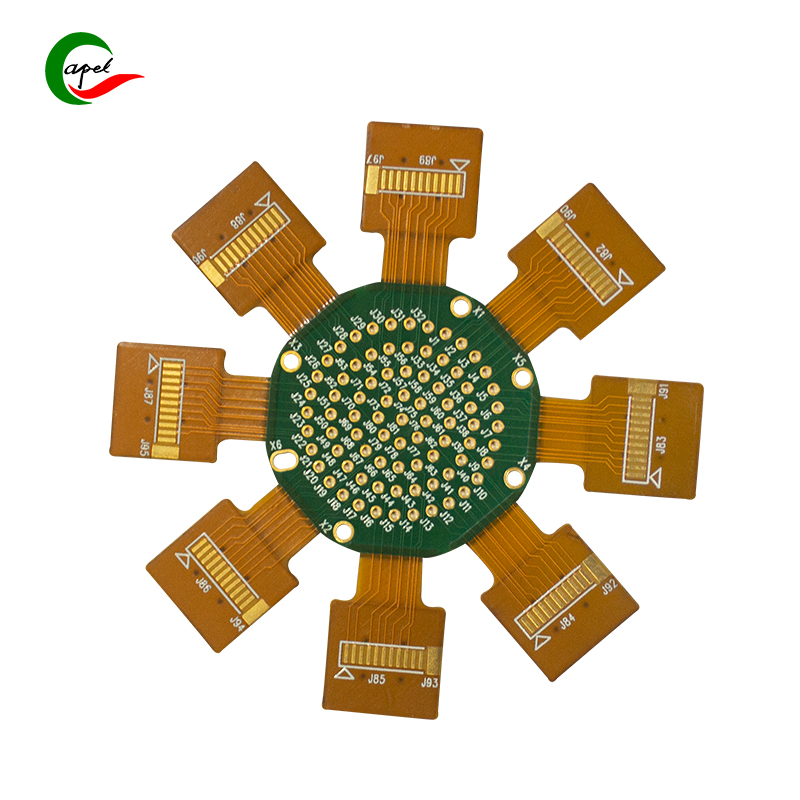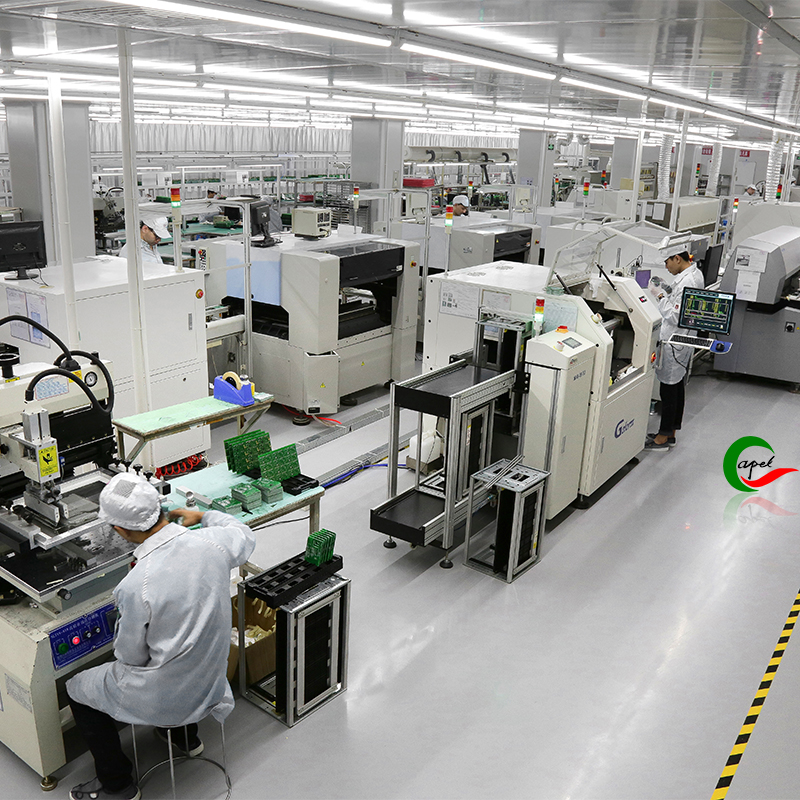Rigid flex PCBs(Rigid flex printed circuit boards) are gaining popularity in electronic devices due to their unique structure that provides both flexibility and rigidity. This combination allows for greater design flexibility and durability, making it ideal for a wide variety of applications. However, before applying these boards in electronic products, their durability must be understood. In this article, we look at the factors that affect the durability of rigid flexible PCB boards and what you can do to ensure their long life.
Material Quality and Selection in rigid flexible PCBs:
The choice of materials used to construct a rigid-flex PCB plays a critical role in determining its overall durability. High-quality materials such as polyimide or specialized substrates such as FR-4 are widely used due to their excellent mechanical and electrical properties. These materials have excellent resistance to bending, flexing, moisture and temperature changes required for many applications.
Polyimide, a common substrate material in rigid-flex PCBs, has excellent thermal stability, allowing the board to withstand high temperatures without compromising its integrity. This feature is especially valuable for electronic equipment that may be subjected to high operating temperatures or extreme environmental conditions.
Additionally, polyimide has a low coefficient of thermal expansion, which means it expands and contracts less with changes in temperature. This feature ensures that the rigid-flex PCB maintains its dimensional stability and prevents any potential damage or failure due to thermal stress.
Specialty substrates such as FR-4 are also widely used in rigid-flex structures due to their excellent mechanical and electrical properties. FR-4 is a flame retardant material with good electrical insulation and high mechanical strength. It is known for its dimensional stability, moisture resistance and ability to withstand high temperatures.
Rigid-flex boards are made of high-quality materials, ensuring they can withstand the rigors of everyday use and environmental conditions. The durability of a PCB is critical to its performance and longevity, especially in applications where it is repeatedly bent and bent.
In addition to material quality, selecting the right material for a specific design requirement is also critical. The choice of material depends on factors such as the operating temperature range, flexibility and mechanical stress requirements, and the moisture and chemical exposure the PCB may encounter. Manufacturers carefully evaluate these factors and select materials that meet these requirements, ensuring the durability of rigid-flex PCBs in their intended applications.
Flexibility and Bend Radius:
Flex and bend radius are key considerations in rigid-flex PCB design and manufacturing. These PCBs are known for their ability to bend without causing damage or failure, making them suitable for applications that require flexibility and durability.
Bend radius is the smallest distance a board can be bent without damaging its components or overall functionality. It is determined by several factors, including the material properties of the PCB, the layout and design of components, and the positioning of traces and vias. Proper design of the bending area is critical to prevent cracking or tearing during manufacturing. This involves ensuring that the board is sized and laid out to accommodate expected flex or flex without compromising component integrity. Also, using copper trace reinforcement in the bend area helps to increase the durability of the board and prevent damage. Consistent workmanship and precise assembly techniques are critical to maintaining the flexibility of rigid-flex PCBs even after multiple bending cycles. This includes attention to detail in soldering, component placement and adherence to industry standards and best practices.
It is important to note that the durability of rigid-flex boards may vary depending on the specific application. Industries such as aerospace or medical often require continuous or extreme flexing and may require more stringent design considerations to ensure long-term reliability and durability. In such cases, additional measures can be taken, such as adding additional reinforcement in critical areas or selecting materials with enhanced bending properties.
Environmental Factors:
The durability of a rigid-flex board is largely influenced by its ability to withstand environmental factors such as temperature changes, humidity, and vibration—all common conditions for electronic devices.
Temperature cycling is a typical reliability test performed on rigid-flex PCBs to evaluate their resistance to extreme temperature fluctuations. Through these tests, manufacturers can identify potential weaknesses in board design or material selection that could lead to failure under specific temperature conditions.
Humidity can also affect the durability of rigid-flex boards. To enhance their resistance, manufacturers often apply specialized coatings or conformal coatings that provide an extra layer of protection. These coatings prevent moisture penetration and protect the PCB from corrosion, extending its lifetime.
Another important environmental factor that affects rigid-flex durability is vibration. Vibration can mechanically stress the board and its components, causing solder joint failure or component detachment. To mitigate the effects of vibration, manufacturers can use techniques such as ribs, adhesives or mechanical mounts to secure components and reduce the effects of vibration.
Additionally, dust, dirt, and other contaminants can affect the performance and longevity of rigid-flex boards. If these contaminants are deposited on the surface of the circuit board, they may cause short circuits, corrosion or insulation breakdown. Proper sealing and protection of circuit boards, as well as regular cleaning and maintenance, are critical to preventing these problems.
Additionally, electromagnetic interference (EMI) can affect the functionality of rigid-flex boards, especially in applications where sensitive components or high-frequency signals are present. Shielding techniques such as ground planes or protective coatings help reduce EMI and ensure the integrity of signal transmission on the board.
The effect of external forces (such as impact or impact) on rigid-flex panels must also be considered. Equipment subjected to rough handling or transportation may be susceptible to physical damage. Therefore, proper packaging, shock-absorbing materials, and protective enclosures are critical to maintaining the durability of the board.
Component and Trace Layout:
Component and trace layout on a rigid-flex board is critical to ensuring its durability. One aspect to consider is the flex area of the board. Rigid-flex boards are designed to bend and bend, but excessive bending in certain areas can put undue stress on components and traces, leading to mechanical failure. By carefully arranging components, designers can minimize the risk of mechanical stress or damage.
Components should be kept away from areas where severe bending occurs. Placing them on stiffer or more stable areas of the board can help protect them from unwanted stress. Also, it is important to consider the size and weight of the components. Larger or heavier components should be placed in areas that are less likely to experience excessive flexing.
Traces and vias are conductive paths on the board that also need to be placed strategically. They should be placed in areas that are less likely to be subjected to bending stress. By avoiding critical bend areas, you reduce the risk of trace damage and the possibility of opens or shorts.
To further enhance the durability of the panels, adhesives can be used to bond and reinforce the ribs. Ribs are thin strips of material inserted between plies to provide structural support. By bonding components and traces to these ribs, their ability to withstand bending and flexing is improved. The adhesive acts as a protective layer, minimizing the possibility of damaging components and traces during bending.
Testing and Certification Standards:
In terms of testing and certification, rigid-flex boards go through various procedures to evaluate their durability and reliability. These tests are critical to ensuring that the board meets the necessary quality and performance standards.
IPC-6013 is an important standard governing rigid-flex testing, published by the Printed Circuits Council (IPC). The standard provides specific requirements and criteria for evaluating these boards. Compliance with IPC-6013 ensures that boards meet industry-accepted guidelines for quality and durability.
Rigid-flex testing usually includes mechanical and electrical testing. Mechanical testing evaluates a circuit board’s ability to withstand bending, bending, and other mechanical stresses it may encounter during its useful life. These tests may include bending, twisting and vibrating the board to simulate real-world conditions. Measure the board’s resistance to these stresses and record any failures or damage.
Electrical testing evaluates the electrical performance and integrity of the rigid flexible board. These tests may include checking for opens, shorts, impedance measurements, signal integrity, and voltage/current testing. By performing these electrical tests, it can be determined that the board meets the required electrical specifications and is functioning properly.
In addition to mechanical and electrical testing, other tests can be performed to evaluate specific characteristics or requirements of rigid-flex boards. This can include testing for thermal performance, flame retardancy, chemical resistance, moisture resistance and reliability under harsh environmental conditions.
Certification is an important aspect of the rigid-flex testing process. Once boards have successfully passed all necessary tests, they can be certified as compliant to the standards outlined in IPC-6013 or other relevant industry standards. This certification assures customers and users that the board is of high quality, reliable and durable.
The durability of rigid flexible PCB boards is the result of careful design, material selection, and manufacturing considerations. By utilizing high-quality materials, employing proper flex mechanisms, addressing environmental challenges, and strategically placing components and traces, manufacturers can ensure that these boards will meet the needs of various applications. While rigid-flex PCBs offer exceptional durability, it is imperative to work with experienced designers and manufacturers to ensure that the specific requirements of each application are met. By adhering to industry standards and conducting thorough testing, manufacturers can guarantee that their rigid-flex PCBs will have the durability and longevity required of today’s electronic devices.
Shenzhen Capel Technology Co., Ltd.established its own rigid flex pcb factory in 2009 and it is a professional Flex Rigid Pcb Manufacturer. With 15 years of rich project experience, rigorous process flow, excellent technical capabilities, advanced automation equipment,comprehensive quality control system, and Capel has a professional experts team to provide global customers with high-precision, high-quality 1-32 layer rigid flex board, hdi Rigid Flex Pcb, Rigid Flex Pcb Fabrication, rigid-flex pcb assembly,fast turn rigid flex pcb,quick turn pcb prototypes.Our responsive pre-sales and after-sales technical services and timely delivery enable our clients to quickly seize market opportunities for their projects.
Post time: Aug-28-2023
Back








